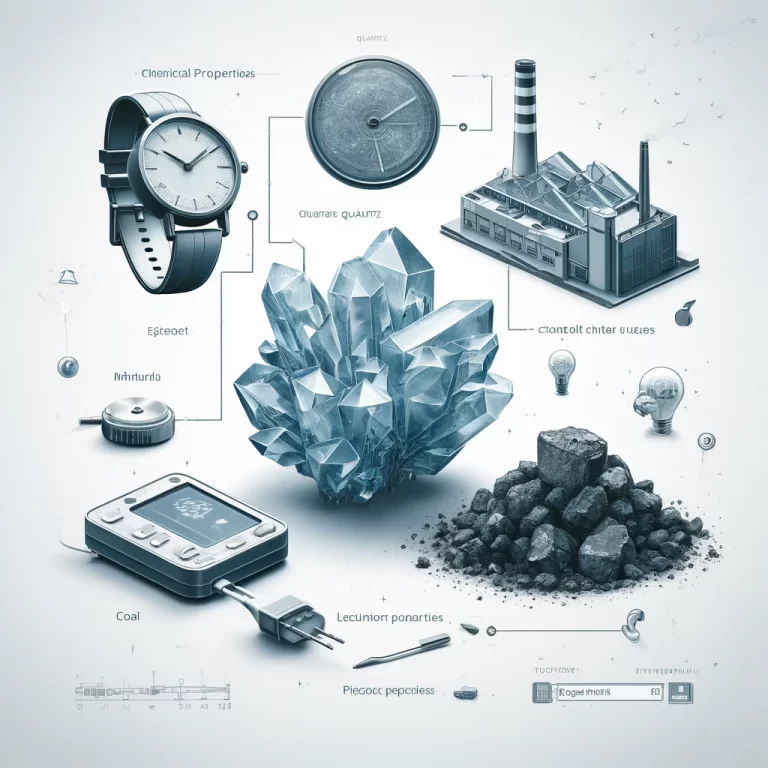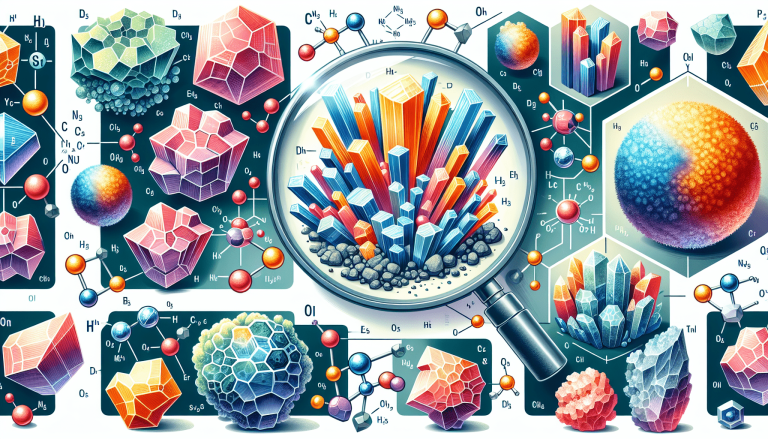Buyers Guide To Understanding Mineral Chemical Properties
So you’re in the market for minerals, but you’re feeling a bit overwhelmed by all the technical jargon surrounding their chemical properties. Whether you’re a beginner or a seasoned collector, this buyer’s guide is here to help you navigate the world of minerals with ease. From explaining the basics of chemical composition to highlighting the key factors that determine a mineral’s quality, this article will provide you with the knowledge you need to make informed buying decisions. So grab a cup of coffee and get ready to discover the fascinating world of mineral chemical properties!

What are mineral chemical properties?
Definition of mineral chemical properties
Mineral chemical properties refer to the characteristics of minerals that are related to their chemical composition. These properties provide crucial information about the internal structure and bonding of minerals, allowing scientists and mineral enthusiasts to identify, classify, and understand the unique properties of different minerals.
Key characteristics of mineral chemical properties
Several key characteristics form the basis of mineral chemical properties. These include hardness, color, streak, cleavage and fracture, luster, specific gravity, crystal form, and chemical composition. Understanding these properties is essential in determining the physical and chemical features of minerals, as well as their potential applications.
Importance of understanding mineral chemical properties
Impact on mineral identification
Understanding mineral chemical properties is vital for accurate mineral identification. Minerals can often have similar physical appearances, making it difficult to distinguish one from another based solely on external characteristics. By examining mineral chemical properties, such as their composition or specific gravity, experts can differentiate between similar-looking minerals and determine their distinct identities.
Effect on mineral usage
Mineral chemical properties also play a significant role in determining the suitability of minerals for various applications. For example, minerals with specific chemical compositions may possess certain desirable qualities, such as heat resistance or electrical conductivity, making them ideal for use in manufacturing industries. Having knowledge of the chemical properties of minerals is essential for selecting the most appropriate mineral for a particular use or application.
Determining mineral quality
Mineral chemical properties serve as critical indicators of mineral quality. By analyzing the chemical composition of minerals, experts can assess their purity, ascertain the presence of impurities or contaminants, and determine the overall value and desirability of the minerals. This information is particularly valuable in industries such as gemology or mining, where the quality of minerals directly impacts their market price and usability.
Common mineral chemical properties
Hardness
Hardness is a mineral chemical property that refers to a mineral’s resistance to scratching or abrasion. It is a measure of the strength of the chemical bonds within a mineral. The Mohs hardness scale, ranging from 1 (softest) to 10 (hardest), is commonly used to quantify this property.
Color
Color is one of the most apparent mineral chemical properties, and it can vary widely across different minerals. Minerals obtain their characteristic colors from various factors, including the presence of specific chemical elements or impurities within their crystal structures.
Streak
Streak refers to the color of a mineral’s powder when it is scraped on a porcelain plate. Unlike color, streak is a more reliable indicator of a mineral’s true identity, as it is less influenced by external factors such as impurities or weathering. Streak colors can differ from the mineral’s external color, providing valuable information for identification purposes.
Cleavage and fracture
Cleavage and fracture are properties related to how minerals break when subjected to external forces. Cleavage refers to the tendency of minerals to break along specific planes due to their internal atomic arrangement, resulting in smooth, flat surfaces. Fracture, on the other hand, describes how minerals break irregularly or unevenly. These properties provide essential clues regarding a mineral’s crystal structure and internal characteristics.
Luster
Luster refers to the way light interacts with the surface of a mineral. It describes the mineral’s level of reflectivity and can vary from metallic to non-metallic. Luster is often used as a diagnostic tool to identify minerals, as different minerals exhibit distinct luster characteristics.
Specific gravity
Specific gravity measures the density of a mineral compared to the density of water. It provides information about the mineral’s relative weight and can be a useful property in distinguishing between minerals with similar appearances. Specific gravity is determined by measuring the mass of the mineral and comparing it to an equal volume of water.
Crystal form
Crystal form describes the external shape and arrangement of a mineral’s crystal structure. It is a result of the internal arrangement of atoms within the mineral, and different minerals can exhibit various crystal forms. Crystal form is a fundamental property used in mineral identification and classification.
Chemical composition
Chemical composition refers to the specific elements and compounds that make up a mineral. Minerals are composed of various combinations of chemical elements, and their composition can greatly influence their physical and chemical properties. Analyzing the chemical composition of minerals provides valuable insights into their unique characteristics and potential applications.
Understanding hardness
Definition of hardness
Hardness is a mineral’s resistance to scratching or abrasion. It is a fundamental property used in mineral identification and classification. The hardness of a mineral is determined by the strength of the chemical bonds within its crystal structure.
Mohs hardness scale
The Mohs hardness scale is a commonly used method to measure and compare the hardness of minerals. It consists of ten minerals, each assigned a hardness value from 1 to 10. For example, talc, the softest mineral, has a hardness value of 1, while diamond, the hardest mineral, has a hardness value of 10.
Measuring hardness
Hardness can be measured using various tools, such as a mineral’s ability to scratch certain materials or by conducting a hardness test with a hardness testing kit. The most common method involves determining whether a mineral can scratch or be scratched by specific minerals on the Mohs scale.
Applications of hardness in mineral identification
Hardness is a crucial property used in mineral identification. By determining the hardness of a mineral, experts can quickly eliminate possibilities and narrow down potential mineral identities. For example, if a mineral can be scratched by a mineral with a hardness of 5 but cannot scratch a mineral with a hardness of 6, the mineral’s hardness would be determined to be between 5 and 6 on the Mohs scale.

The role of color in mineral identification
Causes of color in minerals
The color of minerals can have various causes, including the presence of specific chemical elements or impurities within the mineral’s crystal structure. Different elements absorb and reflect specific wavelengths of light, leading to the display of distinct colors.
Variations in color
Minerals can exhibit a wide range of colors, often due to minor changes in their chemical composition or crystal structure. For example, quartz can appear colorless, white, or pink, depending on the presence of impurities such as iron or manganese.
Impact of impurities on color
Impurities within a mineral’s crystal structure can significantly affect its color. Even a small concentration of impurities can lead to dramatic changes in color. For instance, trace amounts of chromium in corundum result in the vibrant red color of ruby.
Assessing mineral identity through color
While color alone is not always a reliable indicator for definitively identifying minerals, it can provide valuable hints when combined with other properties. Minerals with distinct colors, such as malachite’s vibrant green or sulfur’s bright yellow, can often be easily recognized. However, it is important to consider other factors such as streak, luster, and crystal form to confirm mineral identity accurately.
Using streak to identify minerals
Definition of streak
Streak refers to the color of a mineral’s powder when it is scraped on a porcelain plate. To determine a mineral’s streak, one must crush or scrape the mineral against a hard surface to produce a fine powder.
Streak testing process
To conduct a streak test, one simply needs a porcelain plate or a streak plate. The mineral is rubbed against the streaking surface, producing a colored mark or powder. The color of the streak is then observed and noted.
Interpreting streak colors
Streak colors can vary significantly from the external color of a mineral, providing essential clues for identification. For example, a mineral with a yellow external color may have a streak color that is white or a different color entirely. This difference in color can distinguish minerals that may otherwise appear similar.
Importance of streak in mineral identification
The streak property is valuable in mineral identification because it is less influenced by external factors such as impurities or weathering. By comparing the observed streak color to known streak colors of various minerals, mineral enthusiasts can narrow down potential mineral identities and increase the accuracy of their identification.
Cleavage and fracture characteristics
Difference between cleavage and fracture
Cleavage and fracture are both properties related to how minerals break when subjected to external forces. Cleavage refers to the tendency of minerals to break along specific planes due to their internal atomic arrangement, resulting in smooth, flat surfaces. Fracture, on the other hand, describes how minerals break irregularly or unevenly, usually resulting in rough or jagged surfaces.
Types of cleavage
Minerals can exhibit different types of cleavage, depending on the regularity and orientation of their internal atomic arrangement. Common types of cleavage include basal cleavage, cubic cleavage, and prismatic cleavage. The number and orientation of cleavage planes can vary between minerals.
Fracture patterns
Fracture patterns can provide valuable clues about a mineral’s structural characteristics. Minerals can exhibit different types of fractures, such as conchoidal fracture, where minerals break like curved shells, or fibrous fracture, where minerals break into fibrous strands. Examining a mineral’s fracture patterns can assist in identifying and categorizing minerals.
Examining cleavage and fracture for mineral classification
Cleavage and fracture characteristics are important for mineral classification. They offer insights into a mineral’s internal atomic structure and provide distinguishing features for different minerals. By examining these properties, mineral enthusiasts can identify and differentiate minerals with similar external appearances.
Understanding mineral luster
Definition of luster
Luster refers to the way light interacts with the surface of a mineral. It describes the mineral’s level of reflectivity and is an essential property for mineral identification. Minerals can exhibit a range of luster types, including metallic, vitreous (glassy), pearly, dull, or greasy.
Common types of luster
There are several common types of luster observed in minerals. Metallic luster describes minerals that reflect light similarly to metals. Vitreous luster refers to minerals that have a glass-like appearance and reflect light with a smooth and shiny surface. Pearly luster gives minerals a soft, pearl-like glow, while dull luster reflects very little light and appears matte.
Influencing factors on luster
The luster of a mineral can be influenced by factors such as its composition, crystal structure, and surface texture. The presence of specific elements within the mineral’s chemical composition can contribute to metallic luster, while the arrangement of atoms in the crystal structure affects the way light is reflected.
Determining mineral properties through luster
Luster serves as an important diagnostic property in mineral identification. By examining the reflectivity and appearance of a mineral’s surface, experts can deduce valuable information about its composition and characteristics. Combined with other properties, luster helps identify minerals and distinguish between different mineral species.
Exploring specific gravity
Definition of specific gravity
Specific gravity is a property that measures the density of a mineral compared to the density of water. It provides information about the relative weight of a mineral and its ability to sink or float in a liquid.
Measuring specific gravity
Specific gravity can be measured using several methods, including the hydrostatic balance method and the pycnometer method. These methods involve comparing the weight of a mineral sample in air to its weight in water and calculating the ratio between the two.
Significance of specific gravity in mineral identification
Specific gravity is an important property in mineral identification and classification. Minerals with similar appearances can have different specific gravities, allowing experts to differentiate between them. By comparing a mineral’s specific gravity to known values or ranges for various minerals, one can narrow down potential mineral identities.
Applications of specific gravity in other fields
Specific gravity is not only valuable in mineral identification but also finds applications in various other fields. In geology and hydrology, specific gravity is used to study soil and water properties. It is also useful in the jewelry industry to evaluate gemstone quality and determine authenticity.
Analyzing chemical composition
Elements and compounds in minerals
Minerals are composed of various elements and compounds. Their chemical composition can range from simple combinations of elements to complex mixtures of compounds. The presence of specific elements or compounds greatly influences the physical and chemical properties of minerals.
Quantifying chemical composition
Chemical composition can be quantified through various techniques, such as X-ray fluorescence spectroscopy or atomic absorption spectroscopy. These methods allow for the identification and measurement of the elements present in a mineral and provide information about their relative concentrations.
Using chemical analysis for mineral identification
Chemical analysis is a powerful tool in mineral identification. By comparing the chemical composition of an unknown mineral sample to known compositions of minerals, one can identify and classify the mineral accurately. Chemical analysis also aids in detecting impurities, which can affect a mineral’s characteristics and suitability for various applications.
Impact of chemical composition on mineral characteristics
The chemical composition of a mineral has a profound influence on its properties and behavior. Different elements and compounds can give rise to distinct physical and chemical traits, such as color, hardness, and reactivity. Understanding the chemical composition of minerals helps experts predict and explain their behavior in different environments and applications.
In conclusion, understanding mineral chemical properties is crucial for various purposes, including mineral identification, assessing mineral quality, and determining suitable applications. Properties such as hardness, color, streak, cleavage and fracture, luster, specific gravity, crystal form, and chemical composition provide valuable information about a mineral’s unique characteristics. By studying these properties, experts can identify minerals accurately, evaluate their quality, and discover potential uses in various industries.







